|
Drapeaux de Colomb
|
Colombus' Flags
|
|
|
|
||
|
Mais quel est le drapeau que planta Christophe Colomb sur l'ile de Guanahani le 12 octobre 1492 ?
|
|
But what is the flag that Christopher Colombus planted on the island of Guanahani on October 12, 1492 ?
|
|
1ére hypothèse: Un drapeau jaune portant les armes de Castille.
"La découverte du nouveau monde, par Colomb le 12 octobre 1492". Peinture de John Vanderlyn. Ce tableau a été accroché dans la Rotonde du Capitole à Washington, le 15 Janvier 1847. Cette peinture a souvent servi de modèle pour la réalisation de timbres( voir autres illustrations). Nota: Il s'agit d'une des rares représentations de Colomb barbu. |
|
1st hypothesis: a yellow flag carrying the arms of Castille.
" The discovery of the new world, by Colombus on October 12th, 1492 ". John Vanderlyn's painting. This picture was hung on in the Rotunda of the Capitol in Washington, on January 15th, 1847. This painting often served as model for the realization of stamps (see the other illustrations). Nota bene: It is one of the rare representations of bearded Colombus. |
|
2e hypothèse: Un drapeau aux armes de Castille
C'est le modèle qui fut le plus représenté lors du 2e centenaire. Le dessin est de l'artiste brésilien Ivan Wasth Rodrigues. voir les autres illustrations |
 |
2nd hypothesis: a flag in the arms of Castille.
It is the model which was the most represented during the 2nd centenary. The drawing is of the Brazilian artist Ivan Wasth Rodrigues. see the other illustrations |
|
3e hypothèse: Un drapeau blanc portant un aigle héraldique aux armes des rois d'Espagne.
C'est une thèse présentée dans FOTW Remarque: il n'y avait pas de prêtre dans l'expédition de découverte de l'Amérique |
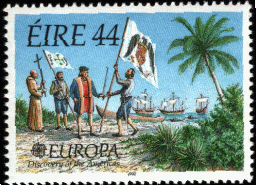  |
3rd hypothesis: a white flag carrying a heraldic eagle with arms of kings of Spain.
It is a thesis presented in FOTW. Notice: there was no priest in the expedition of discovery of America |
|
4e hypothèse: Un drapeau blanc frappé d'une croix verte et des initiales F et Y des souverains Ferdinand d'Aragon et Ysabelle de Castille.
Ce drapeau particulier est souvent représenté dans les illustrations mais généralement portés par les capitaines des deux autres caravelles. |
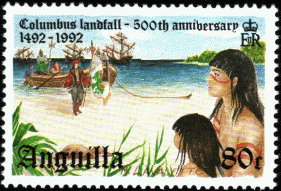 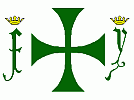 |
4th hypothesis: a white flag struck by a green cross and initials F and Y sovereigns Ferdinand of Aragon and Ysabelle of Castille.
This particular flag is often represented in the illustrations but generally carried by the captains of the two other caravels. |
|
5e hypothèse: Le même drapeau mais jaune avec croix et initiales rouges.
|
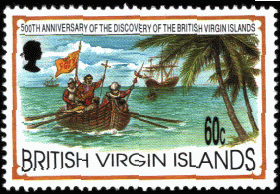 |
5th hypothesis: the same flag but yellow with cross and initials red.
|
|
6e hypothèse: Un drapeau jaune à croix rouge
Gravure d'Epinal 19e siècle |
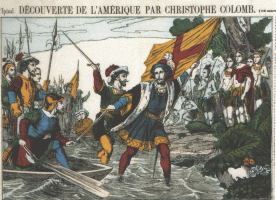 |
6th hypothesis: a yellow flag with red cross.
Engraving of Epinal (east of France) 19th century |
|
7e hypothèse: Un drapeau jaune et rouge du roi d'Aragon
Gravure du livre de Théodore de Bry (1559) voir sur cette thèse, le site http://www.bcngrafics.com/xpoferens/c17.html |
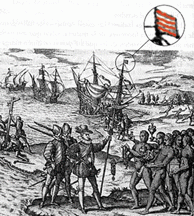 |
7th hypothesis: a yellow and red flag of king of Aragon.
Engraving of the book of Théodore de Bry (1559 ) . See on this thesis, the site http://www.bcngrafics.com/xpoferens/c17.html |
|
8e hypothèse: Une bannière aux armes de Castille
La bannière est un tissu rectangulaire suspendu verticalement sur une traverse bois. |
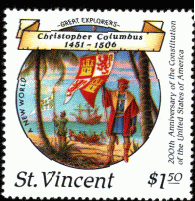 |
8th hypothesis: a banner in the arms of Castille.
The banner is an rectangular tissue suspended vertically on a crossbar wood. |
|
9e hypothèse: Une bannière portant les armes royales.
Voici ce que dit Bartolomé de las Casa, dans son "Histoire des Indes", rédigéee d'aprés les documents de Colomb, terminée en 1564 et publiée pour la premiere fois en Espagne en 1875 : "L'Amiral déploya la bannière royale et ses deux capitaines chacun une bannière à croix verte que l'Amiral avait mises sur chaque navire comme marque et devise, portant un F, qui désigne le roi D. Fernando, et un Y, pour la reine Ysabel, chaque lettre étant surmontée de sa couronne respective et placée l'une d'un coté de la croix et l'autre de l'autre." Texte indiqué par Jean-Michel Urvoy, président de l'association http://www.cristobal-colon.net/Asso/asso.htm et membre de la Société Royale Colombine de Huelva. |
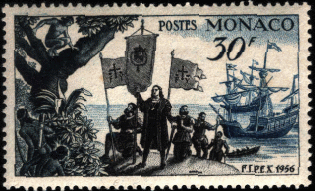 |
9th hypothesis: a banner carrying the royal arms.
Here is what says Bartolomé de las Casa, in his "History of India", writed with documents of Colombus, ended in 1564 and published for the first time in Spain in 1875: " The Admiral displayed the royal banner and his two captains each a banner with green cross that the Admiral had put on every ship as mark and device, carrying one F, which indicates king D. Fernando, and one Y, for queen Ysabel, every letter being surmounted by its respective and placed crown one of a highly-rated of the cross and other one of the other one. " Texte indicated by Jean-Michel Urvoy, president of the association http://www.cristobal-colon.net/Asso/asso.htm and member of the Société Royale Colombine de Huelva. |
|
10e hypothèse: Une grande bannière dorée avec les armes des deux souverains.
|
 |
10th hypothesis: a big banner golded with the weapons of both sovereigns.
|
|
11e hypothèse: Une bannière rouge représentant un Christ en croix.
voir les autres illustrations sur les bannières |
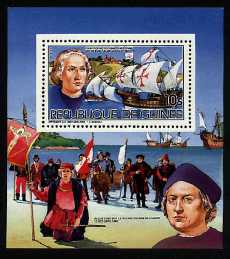 |
11th hypothesis: a red banner representing a Crucifixion.
See the other illustrations on banners |
|
12th hypothesis: une bannière représentant la vierge à l'enfant.
On peut remarquer que le costume de Colomb est très ressemblant à celui de l'illustration précédente. Illustration provenant du film "Christophoro Colombo" réalisé en 1985 par Alberto Lattuada. |
 |
12th hypothesis: a banner representing the virgin to the child.
We can notice that the suit of Colomb is very resembling in that of the previous illustration. Illustration from the movie "Christophoro Colombo" directed in 1985 by Alberto Lattuada. |
|
13e hypothèse: Une bannière blanche portant une croix rouge
Les timbres italiens en général n'aiment pas représenter le drapeau castillan. |
 |
13e hypothesis: A white banner carrying a red cross.
The Italian stamps in general do not like to represent the Castilian flag . |
|
14e hypothèse: Une bannière rouge blanche rouge avec deux lions
Decoration de la maison natale del Libertador Bolivar au Vénézuela par Tito Salas (1888-1974) La plus curieuse: que représente cette bannière |
  |
14e hypothesis: A red white red banner with two lions.
Decoration of the native house del Libertador Bolivar in Vénézuela by Tito Salas ( 1888-1974 ) The most curious: what represents this banner |
|
15e hypothèse: Une bannière aux couleurs de l'Espagne
Mosaïque Colombusgasse - Vienne - Autriche C. Sandig (1966) La plus fausse: le tribande rouge-jaune-rouge ne fut adopté par l'Espagne qu'en 1785. Photo: Peter van der Krogt, |
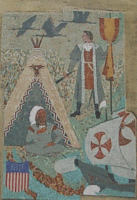 |
15e hypothesis: A banner with the colors of Spain.
Mosaic Colombusgasse - Vienna - Austria The falsest: the triband red-yellow-red was adopted by Spain only in 1785. Photo: Peter van der Krogt, |
|
16e hypothèse: Des drapeaux de couleurs différentes mais généralement mal définis.
Le dessinateur indique la présence symbolique d'un drapeau mais évite de prendre parti quant à sa représentation réelle. |
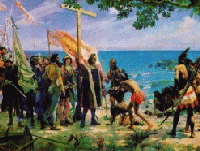 |
16e hypothesis: Flags of different colors but generally badly definite.
The draughtsman indicates the symbolic system presence of a flag but avoids taking party as for his real representation. |
|
Toutes ces illustrations doivent etre considérées commes des images fantaisistes. Il n'y avait pas de photographes dans l'expédition de Colomb et les documents écrits d'époque ne sont pas très explicites. Les dessinateurs ont donc inventé et les représentations qu'ils ont créé témoignent surtout des connaissances et croyances de leur époque.
All these illustrations must be considered likes fancy pictures. There were no photographers in the forwarding of Colomb and the written documents of time are not very explicit. The draughtsmen thus invented and the representations which they created testify especially to knowledge and beliefs of their time. |
||
|
Les illustrations utilisés proviennent de timbres de la collection personnelle de l'auteur ou des sites L'Amiral de la Mer Océane , Colombus Monument Pages , Christophe Colomb ou le Rêve Américain . Les blasons et drapeaux proviennent de Flag of the World.
|
||
|
|
||